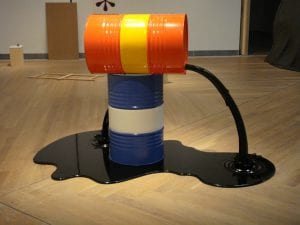Aroon Indicator: Unveiling Market Insights and Trend Analysis.
Aug 11, 2023
In technical analysis, traders and investors rely on various indicators to gain insights into the market’s direction and make informed decisions. One such tool is the Aroon indicator, which provides valuable information about trends and potential reversals. This post will explore the Aroon indicator, how it works, and how to use it effectively in your trading strategies.
The Aroon indicator is a technical analysis tool developed by Tushar Chande to identify the strength and direction of a trend, as well as potential trend reversals. It consists of two lines: the Aroon Up line and the Aroon Down line. The Aroon Up line measures the number of periods since the highest high within a given timeframe, while the Aroon Down line measures the number of periods since the lowest low.
How Does the Aroon Indicator Work?
The Aroon indicator operates based on the concept that solid trends tend to have new highs or lows within a specific timeframe. By calculating the time elapsed since the most recent high or low, the Aroon indicator can determine the strength and direction of the trend.
The Aroon Up line ranges from 0 to 100, with 100 indicating a new high reached within the specified period. Conversely, the Aroon Down line also ranges from 0 to 100, with 100 showing a new low achieved within the specified period. The closer each line is to 100, the stronger the trend in the corresponding direction.
Interpreting the Aroon Indicator:
The Aroon indicator is a useful tool for identifying trends and potential trend reversals in the market. It consists of two primary signals: Aroon Up and Aroon Down. By understanding how to interpret these signals, traders can gain valuable insights into market dynamics and make informed investment decisions.
Aroon Up measures the strength of an uptrend, while Aroon Down measures the strength of a downtrend. When the Aroon Up line consistently stays above 70, it suggests a strong uptrend is in place. On the other hand, values below 30 indicate a weak trend. Similarly, when the Aroon Down line consistently stays above 70, it signals a strong downtrend, while values below 30 indicate a weak trend.
Traders can use the Aroon indicator to identify potential trend reversals. For example, if the Aroon Up line crosses above the Aroon Down line, it may indicate a shift from a downtrend to an uptrend. Conversely, if the Aroon Down line crosses above the Aroon Up line, it may suggest a shift from an uptrend to a downtrend. These crosses can serve as early warning signals for traders to adjust their positions or enter new trades.
Additionally, the Aroon indicator can be combined to form the Aroon Oscillator, which measures the difference between the Aroon Up and Aroon Down lines. The oscillator fluctuates between -100 and +100, with positive values indicating an uptrend and negative values indicating a downtrend. Traders can use the Aroon Oscillator to identify overbought or oversold conditions in the market, potentially signalling a reversal or a correction in the prevailing trend.
Overall, the Aroon indicator provides valuable insights into trend strength and potential trend reversals. By understanding how to interpret the Aroon Up and Aroon Down lines and the Aroon Oscillator, traders can make more informed decisions and enhance their trading strategies.
Aroon Oscillator:
The Aroon Oscillator is a powerful tool derived from the Aroon indicator, providing additional insights into market trends. It is calculated by subtracting the Aroon Down line from the Aroon Up line. The resulting values can range from -100 to +100.
Positive values of the Aroon Oscillator indicate an uptrend, suggesting that the Aroon Up line is stronger than the Aroon Down line. Conversely, negative values indicate a downtrend, indicating that the Aroon Down line is stronger. Values close to zero suggest a lack of trend or a consolidation phase in the market.
Traders can use the Aroon Oscillator to identify potential trend reversals. For example, if the Aroon Oscillator crosses above zero, it may signal a shift from a downtrend to an uptrend. Conversely, if it crosses below zero, it may indicate a change from an uptrend to a downtrend. These crossovers can serve as early warning signals for traders to adjust their positions or enter new trades.
The Aroon indicator is a versatile tool that can be used in various ways for technical analysis. It provides valuable insights into market trends and can help traders make informed trading decisions.
Identifying Trends:
One of the primary applications of the Aroon indicator is to identify market trends. By analyzing the Aroon Up and Aroon Down lines, traders can determine whether an uptrend or downtrend is dominant. Aroon values above 50 suggest a strong trend, while values below 50 indicate a weaker trend. Monitoring the Aroon lines can help traders stay aligned with the prevailing market direction.
For example, if the Aroon Up line is consistently above 50 and the Aroon Down line is consistently below 50, it suggests a strong uptrend. Conversely, if the Aroon Down line is consistently above 50 and the Aroon Up line is consistently below 50, it indicates a strong downtrend. These indications can help traders make decisions such as entering trades in the direction of the trend or adjusting their risk management strategies accordingly.
Additionally, traders can use the Aroon Oscillator to gauge the strength of a trend. Higher positive values indicate a stronger uptrend, while lower negative values suggest a stronger downtrend. This information can be helpful in determining a trend’s potential duration and intensity, allowing traders to adjust their trading strategies accordingly.
In conclusion, the Aroon indicator and Aroon Oscillator provide valuable insights for technical analysis. These tools allow traders to identify trends, anticipate potential trend reversals, and make informed trading decisions. Incorporating the Aroon indicator into their technical analysis toolkit can enhance traders’ ability to navigate the dynamic and ever-changing financial markets.
Spotting Reversals
The Aroon indicator is not only helpful in identifying trends but also for spotting potential trend reversals. By monitoring the crossovers between the Aroon Up and Aroon Down lines, traders can gain insights into possible shifts in market direction.
When the Aroon Up line crosses above the Aroon Down line, it suggests a potential reversal from a downtrend to an uptrend. This crossover indicates that the buying pressure is increasing, potentially leading to a bullish market sentiment. Traders may interpret this as a signal to consider long positions or exit short ones.
Conversely, when the Aroon Down line crosses above the Aroon Up line, it indicates a potential reversal from an uptrend to a downtrend. This crossover suggests that the selling pressure is increasing, potentially leading to a bearish market sentiment. Traders may interpret this as a signal to consider short positions or exit long ones.
It’s important to note that crossovers alone may not guarantee a trend reversal. Traders should consider other technical indicators, market conditions, and fundamental factors before trading decisions to confirm the potential reversal. Stop-loss orders and risk management strategies are crucial to protect against false signals and manage potential losses.
Aroon Indicator Strategies:
Traders often develop strategies based on the Aroon indicator to enhance their trading performance. Here are a few examples:
1. Trend Confirmation Strategy: Traders can use the Aroon indicator to confirm the strength of a trend identified by other technical indicators. For example, if a moving average crossover signals an uptrend, traders can look for the Aroon Up line to be consistently above 50, indicating a strong bullish trend. This confirmation can provide additional confidence in the trading decision.
2. Breakout Strategy: Traders can use the Aroon indicator to identify potential breakout opportunities. When the Aroon Up line crosses above 70, it suggests a strong uptrend, which may indicate a breakout to the upside. Traders can consider entering long positions when this occurs, anticipating further price appreciation.
3. Divergence Strategy: Traders can also look for divergences between the Aroon indicator and price action. For example, if the price is higher, but the Aroon indicator is lower, it may indicate a potential trend reversal. Traders can use this divergence as a signal to consider exiting or reversing their positions.
It’s essential for traders to backtest and validate any strategy before implementing it in live trading. Each trader may have their unique approach and risk tolerance, so adapting the Aroon indicator strategies to individual trading styles is essential.
In conclusion, the Aroon indicator is a versatile tool to help traders spot potential trend reversals and develop effective trading strategies. By combining the Aroon indicator with other technical analysis tools and risk management techniques, traders can enhance their decision-making process and improve their overall trading performance.
Fascinating read: Technical Analysis Of Financial Markets: Dangerous Signals
Trend-Following Strategy:
A widely employed strategy that leverages the Aroon indicator involves confirming trends and entering trades in alignment with the prevailing market direction. By using the Aroon indicator, traders can identify strong trends and seize entry opportunities that align with those trends.
In an uptrend scenario, traders closely monitor the Aroon Up line and patiently wait for it to cross above the 70 level. This crossing indicates a robust uptrend and acts as a confirmation signal. Once the Aroon Up line crosses above 70, traders can actively seek entry opportunities to buy, capitalizing on the market’s upward momentum. This strategy allows traders to align their trades with the prevailing bullish trend, increasing the potential for profitable outcomes.
Conversely, traders shift their focus to the Aroon Down line in a downtrend. They patiently observe the Aroon Down line and wait for it to cross above 70. This crossover signals a strengthening downtrend and serves as confirmation. When the Aroon Down line surpasses 70, traders may consider short-selling opportunities, taking advantage of the downward momentum in the market. This strategy allows traders to align their trades with the prevailing bearish trend, potentially maximizing their gains in a declining market.
It’s important to note that while the Aroon indicator can provide valuable insights for trend-following strategies, it is advisable to use additional analysis tools and indicators to strengthen the overall trading approach. This may include incorporating other technical indicators, such as moving averages or volume indicators, to validate signals and enhance decision-making.
By incorporating the Aroon indicator into a trend-following strategy and combining it with other analysis techniques, traders can increase their ability to identify and participate in profitable trends. This approach allows traders to ride the waves of market momentum and potentially achieve favourable trading outcomes.
Reversal Strategy:
An effective strategy utilizing the Aroon indicator involves identifying potential trend reversals and taking contrarian positions. Traders can monitor the Aroon Up line and wait for it to cross below 30, indicating a weakening uptrend. This may serve as a signal to consider selling positions. Conversely, a cross of the Aroon Down line below 30 in a downtrend suggests a weakening downtrend, presenting a buying opportunity. By leveraging these reversal signals, traders can capitalize on market shifts and make informed trading decisions.
When the Aroon Up line crosses below 30, it suggests that the buying pressure is diminishing, potentially signalling a trend reversal. Traders can interpret this as an opportunity to exit long positions or consider short positions. This strategy allows traders to exploit potential price declines and profit from market reversals.
Similarly, when the Aroon Down line crosses below 30, it indicates a weakening downtrend. This crossover suggests that the selling pressure is diminishing, potentially signalling a trend reversal to the upside. Traders can interpret this as an opportunity to exit short positions or consider long positions. By taking contrarian positions, traders can benefit from potential price increases as the market sentiment shifts.
It’s important to note that reversal signals from the Aroon indicator should be used in conjunction with other technical analysis tools and market indicators to confirm the potential trend reversal. Traders should consider factors such as volume, support and resistance levels, and overall market conditions to validate the signals and make well-informed trading decisions.
Risk management is crucial when implementing a reversal strategy. Setting stop-loss orders and defining risk-reward ratios can help protect against potential losses and manage risk exposure. Traders should also be mindful of false signals and market volatility, adjusting their positions and strategies accordingly.
By incorporating the Aroon indicator into a reversal strategy, traders can identify potential trend reversals and take contrarian positions to capitalize on market shifts. This approach allows traders to stay ahead of the curve and make informed trading decisions based on changing market dynamics.
Limitations of the Aroon Indicator:
While the Aroon indicator can be a valuable tool in technical analysis, knowing its limitations is essential. Understanding these limitations can help traders make more informed decisions and avoid potential pitfalls.
1. Trending Market Bias: The Aroon indicator performs best in trending markets, where it can provide reliable signals for identifying trend strength and potential reversals. However, the Aroon indicator may generate false or unclear signals in choppy or sideways markets, where trends are less defined. Traders should exercise caution when using the Aroon indicator in market conditions and consider using additional indicators or analysis techniques to confirm signals.
2. Lagging Indicator: Like many technical indicators, the Aroon indicator is lagging, meaning it relies on past price data to generate signals. This lag can result in delayed signals, causing traders to enter or exit positions later than desired. To mitigate this limitation, traders can consider using the Aroon indicator with leading indicators or price action analysis to get a more comprehensive view of market conditions.
3. Lack of Precision: The Aroon indicator provides a general indication of trend strength and potential reversals but does not provide precise entry or exit points. Traders should use the Aroon indicator as part of a broader trading strategy incorporating other technical indicators, chart patterns, and fundamental analysis to refine their entry and exit points.
4. Market Noise: The Aroon indicator may be susceptible to false signals or noise in the market, especially during periods of high volatility or news events. Traders should exercise caution and consider the overall market context when interpreting Aroon indicator signals.
To overcome these limitations, using the Aroon indicator in conjunction with other technical indicators, such as moving averages, oscillators, or volume analysis, is recommended. Additionally, incorporating fundamental analysis and staying informed about market news and events can provide a more comprehensive understanding of market conditions.
By understanding the limitations of the Aroon indicator and using it as part of a well-rounded trading approach, traders can make more informed decisions and improve their overall trading performance.
Conclusion
The Aroon indicator is an invaluable tool for technical analysis, offering valuable insights into market trends and potential reversals. By comprehending the interplay between the Aroon Up and Aroon Down lines, traders can better understand market dynamics and make more astute trading decisions. Whether employed in trend-following strategies or to identify reversals, the Aroon indicator can enhance a trader’s ability to navigate the intricacies of financial markets effectively.
By thoroughly understanding the Aroon indicator and its versatile applications, traders and investors can amplify their technical analysis skills and make well-informed decisions within the dynamic financial landscape. The Aroon indicator is invaluable for market participants seeking a competitive edge in their trading endeavours, whether utilised to identify trends, pinpoint reversals, or formulate specific trading strategies.
Now is the opportune moment to harness the power of the Aroon indicator and unlock new opportunities in your trading journey. Take the first decisive step towards enhancing your technical analysis skills and gaining a substantial market edge. Remember that successful trading necessitates knowledge, strategy, and disciplined execution. The Aroon indicator can be a potent addition to your trading tools, empowering you to navigate the ever-changing financial landscape confidently and precisely. Begin leveraging its power today and elevate your trading potential to new heights.
https://www.youtube.com/watch?v=u-JTmhS1XDw
FAQ
Q: Can the Aroon indicator be used for short-term trading?
A:Yes, it can be applied to various timeframes, including short-term trading. It can help identify short-term trends and potential reversals.
Q: Are there any alternative indicators to consider alongside the Aroon indicator?
A: Traders often combine this indicator with other technical indicators like moving averages or oscillators to validate signals and strengthen their analysis.
Q: Is the Aroon indicator suitable for all financial markets?
A: The Aroon indicator can be applied to various markets, including stocks.
Q: Can the Aroon indicator be used as a standalone trading strategy?
A: While the Aroon indicator can provide valuable insights, combining it with other analysis tools and indicators is recommended to form a comprehensive trading strategy.
Q: How often should I monitor the Aroon indicator?
A: The frequency of monitoring the indicator depends on your trading style and timeframe. Some traders prefer to check it daily, while others may use it weekly or hourly.
Q: Are there any limitations to the indicator’s accuracy?
A: Like any technical indicator, the Aroon indicator is not infallible. Considering it with other indicators, performing a thorough analysis, and managing risk effectively is essential.
Q: Can this indicator be applied to cryptocurrency markets?
A: Yes, the Aroon indicator can be applied to cryptocurrency markets like any other financial market. It can assist in identifying trends and potential reversals in cryptocurrencies.
A World of Ideas: Articles That Will Expand Your Horizons
Market Update Tactical Investor Past Calls: The Trend Is Your Friend
Stocks Will Crash One Day: So What’s The Big Deal
Crude Oil Market Crash: Technical Outlook 2016
Oil Supply Outstrips Demand: Oil Headed Lower 2016

Oil Crash: Crude oil price heading lower 2016

Essentials of understanding Psychology: How To Make Money
Oil market crashes but oil tanker market raking in profits
Longest Bull Market Destined To Run Longer & Trend Much Higher
Hype and financial deception around the block
Oil Tankers trading higher: NAT & FRO TOP Tanker stocks
Stock Market Correction History: Decoding Illusions Behind Crashes



